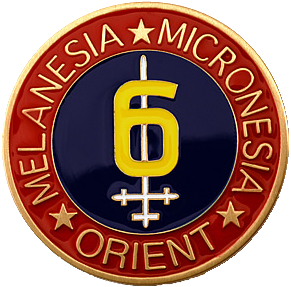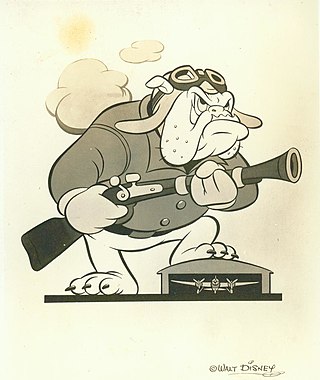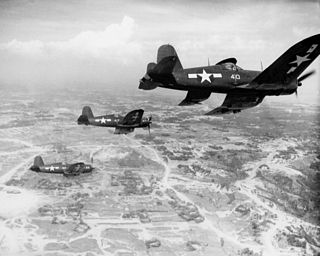
The 6th Marine Division was a United States Marine Corps World War II infantry division formed in September 1944. During the invasion of Okinawa it saw combat at Yae-Take and Sugar Loaf Hill and was awarded a Presidential Unit Citation. The 6th Division had also prepared for the invasion of Japan before the war ended. After the war it served in Tsingtao, China, where the division was disbanded on April 1, 1946, being the only Marine division to be formed and disbanded overseas and never set foot in the United States.

Marine Defense Battalions were United States Marine Corps battalions charged with coastal and air defense of advanced naval bases during World War II. They maintained large anti-ship guns, anti-aircraft guns, searchlights, and small arms to repel landing forces.

Kenneth Wachter Benner was a decorated officer in the United States Marine Corps with the rank of Brigadier general. A graduate of the United States Naval Academy, he trained as Anti-Aircraft Artillery officer and participated in the Defense of Pearl Harbor, Guadalcanal Campaign and Battle of Okinawa.

The History of ground based air defense in the United States Marine Corps dates back to the early 1930s with the establishment of the Advanced Base Force. World War II would be the high-water mark for air defense units when 20+ defense/anti-aircraft battalions were formed with many seeing significant action throughout the Pacific Theater. Following the war, the Marine Corps divested itself of most of its air defense capability at a time when the service was facing deep personnel cuts and fighting for its institutional survival. Beginning in the early 1950s the Marine Corps aligned itself with the Navy and their development of surface-to-air missiles (SAMs). The Marine Corps retained both flak weapons and SAMs throughout the 1950s until the fielding of the MIM-23 Hawk Missile System in 1960. The HAWK Missile was employed by Light Antiaircraft Missile (LAAM) battalions and remained a mainstay of Marine Corps ground based air defense for the next four decades.
The 2d Antiaircraft Artillery Battalion was a United States Marine Corps antiaircraft unit that served during World War II. Formed in 1940 as the 2d Defense Battalion, its original mission was to provide air and coastal defense for advanced naval bases. During the war the battalion defended Hawaii, Tutuila in American Samoa and Guam and took part in combat operations at Tarawa Atoll and Okinawa. The battalion returned to the United States after the war and was decommissioned at Marine Corps Base Camp Pendleton, California on 28 November 1945.

The 8th Antiaircraft Artillery Battalion was a United States Marine Corps antiaircraft unit that served during World War II. Formed in 1942 as the 8th Defense Battalion, its original mission was the air and coastal defense of advanced naval bases. During the war the battalion defended Tutuila in American Samoa, Wallis Island and Apamama and took part in combat operations at Okinawa. The battalion returned to the United States after the war and was decommissioned on 28 November 1945.
The 16th Antiaircraft Artillery Battalion was a United States Marine Corps antiaircraft unit that served during World War II. Formed in 1942 as the 16th Defense Battalion, its original mission was the air and coastal defense of advanced naval bases. During the war the battalion defended Johnston Island, Hawaii and Tinian and took part in combat operations at Okinawa. The battalion returned to the United States after the war and was decommissioned on 30 November 1945 at Marine Corps Base Camp Pendleton, California.

The 12th Antiaircraft Artillery Battalion was a United States Marine Corps antiaircraft unit that served during World War II. Formed in 1942 as the 12th Defense Battalion, its original mission was providing air and coastal defense for advanced naval bases. During the war the battalion defended the Russell Islands and took part in combat operations at Woodlark Island, Cape Gloucester, and Peleliu. The battalion remained on Peleliu for the duration of the war and was finally decommissioned on Guam on 22 September 1945.

The 2d Antiaircraft Artillery Battalion (Composite) (2d AAA Bn [Composite]) was a United States Marine Corps antiaircraft unit that served during World War II. Formed in 1943 as the 3d Airdrome Battalion, its original mission was strictly providing air defense. On 1 October 1943 the battalion was redesignated the 18th Defense Battalion. During the war the battalion provided air defense for the Saipan and Tinian area of operations. The battalion returned to Marine Corps Base Camp Lejeune, North Carolina after the war receiving its final designation on 16 May 1946. The battalion was decommission in September 1947.
The 4th Antiaircraft Artillery Battalion was a United States Marine Corps antiaircraft unit that served during World War II. Formed in 1940 as the 4th Defense Battalion, its original mission was providing air and coastal defense of advanced naval bases. It was one of first five defense battalions deployed in support of the color-coded war plans that called for the defense of Hawaii and other outlying United States possessions in the Pacific Ocean. These five battalions were nicknamed the "Rainbow Five." During the war the battalion took part in combat operations during the attack on Pearl Harbor and at Vella Lavella. The battalion was decommissioned on 9 June 1945 before the end of the war.
The 5th Antiaircraft Artillery Battalion was a United States Marine Corps antiaircraft unit that served during World War II. Formed in 1940 as the 5th Defense Battalion, its original mission was providing air and coastal defense for advanced naval bases. Prior to World War II the battalion deployed to Iceland as part of the 1st Provisional Marine Brigade in order to defend the neutral country from possible German attack. Following the Iceland deployment and a period of rest and refitting at home the battalion again deployed overseas to provide air defense for Funafuti in the Ellice Islands from September 1942 through February 1944. Also in 1942, two batteries from the 5th were dispatched to support operations on Tulagi during the Guadalcanal Campaign. These two batteries were later reorganized as part of the newly formed 14th Defense Battalion. The 5th Defense Battalion was re-designated as the 5th Antiaircraft Artillery Battalion in April 1944 and took part in the Battle of Okinawa in 1945. After the war the battalion returned to the United States where it was decommissioned in November 1945. Because the 14th Defense Battalion was formed from batteries belonging to the 5th Defense Battalion the two units retained close ties throughout the war. The 14th was nicknamed "Five:Fourteenth" and after the war the battalions formed a single alumni association.
The 7th Antiaircraft Artillery Battalion was a United States Marine Corps antiaircraft unit that served during World War II. Formed in 1940 as the 7th Defense Battalion, its original mission was to provide air and coastal defense for advanced naval bases. It was one of first five defense battalions deployed in support of the color-coded war plans that called for the defense of Hawaii and other outlying United States possessions in the Pacific Ocean. These five battalions were nicknamed the "Rainbow Five." During the war the battalion defended Tutuila, Upolu, Savai'i and Nanumea and took part in combat operations at Anguar. The 7th was decommissioned before the end of World War II on 2 August 1945.
The 10th Antiaircraft Artillery Battalion was a United States Marine Corps antiaircraft unit that served during World War II. Formed in 1942 as the 10th Defense Battalion, its original mission was to provide air and coastal defense for advanced naval bases. During the war the battalion took part in combat operations in the Russell Islands and at the Eniwetok. The battalion's tank platoon also saw extensive action on New Georgia and Arundel Island. The battalion was decommissioned before the end of the war on 25 November 1944.

The 17th Antiaircraft Artillery Battalion was an antiaircraft unit in the United States Marine Corps that served during World War II. The battalion was originally formed in 1942 as the 2d Airdrome Battalion and has the distinction of being the last defense battalion formed in the Marine Corps during the war. Its original mission was to provide air and coastal defense for advanced naval bases. During the war the battalion spent significant time defending Nukufetau and took part in combat operations at Tarawa and Tinian. The battalion was decommissioned on December 6, 1945.
The 15th Antiaircraft Artillery Battalion was an antiaircraft unit in the United States Marine Corps that served during World War II. The battalion was originally formed in 1942 as the 1st Airdrome Battalion. Its original mission was to provide air defense for advanced naval bases. During the war the battalion took part in combat operations in the Marshall. The battalion was one of the first defense battalions to be decommissioned on November 25, 1944.
The 14th Antiaircraft Artillery Battalion was an antiaircraft unit in the United States Marine Corps that served during World War II. The battalion was originally formed in 1943 as the 14th Defense Battalion. Its mission was to provide air and coastal defense for advanced naval bases. During the war the battalion took part in combat operations in the Solomon Islands and on Guam. The battalion was decommissioned on June 30, 1945. Since then no other unit has carried the lineage and honors of the 14th Antiaircraft Artillery Battalion.

The 3d Antiaircraft Artillery Battalion (Composite) (3d AAA Bn (Composite)) was an antiaircraft unit in the United States Marine Corps that served during World War II. The battalion was originally formed in 1943 as the 52d Defense Battalion, one of the first African American units in the Marine Corps. Its original mission was to provide air and coastal defense for advanced naval bases. During the war the battalion served as garrison forces on Roi-Namur, Majuro, and Guam. The battalion returned to Marine Corps Base Camp Lejeune, North Carolina after the war. It was the last of the defense battalions before it was re-designated as the 3d Antiaircraft Artillery Battalion in May 1946. The battalion was decommissioned on May 15, 1947.

The Tactical Air Force, Tenth Army (TAF) was a joint aviation command of the Tenth United States Army that was responsible for commanding all land-based aviation and aviation command and control units during the Battle of Okinawa. The TAF's headquarters was provided by the 2nd Marine Aircraft Wing and it was the largest joint aviation unit under Marine Corps command during World War II. During the battle, the TAF was commanded by Major General Francis P. Mulcahy until ill-health forced him to be relieved by MajGen Louis E. Woods. According to United States sources, TAF aircraft were responsible for shooting down 637 Japanese aircraft during the battle.
Marine Aircraft Group 43 (MAG-43) was a fixed wing aviation group in the United States Marine Corps Reserve based at Naval Air Station Joint Reserve Base Willow Grove, Pennsylvania.

The Raid on Yontan was an Empire of Japan military operation carried out on the night of May 24–25, 1945 against Yontan Airfield on Okinawa. The airfield was recently seized by American forces during the first day of the Battle of Okinawa and was being used by United States Marine Corps and Army Air Force squadrons. Five Imperial Japanese Army Mitsubishi Ki-21 bombers, carrying Giretsu Kuteitai special airborne attack troops, conducted a suicide raid against Kadena and Yontan airfields on Okinawa. Four were shot down, but the fifth belly landed on the principal runway at Yontan allowing 10-12 giretsu troops to disembark on the airfield. The raid resulted in the destruction or damaging of 38 American aircraft and 70,000 gallons of fuel. However, its overall value was minimal because Yontan Airfield was reopened at 0800 the following morning with little effect to overall allied aviation operations.












